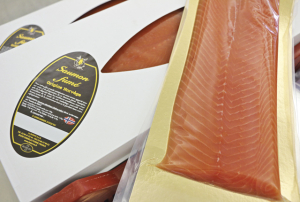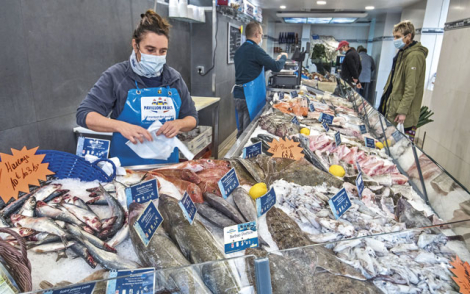Initiated in the countryside of Burgundy, the production of Le Borvo’s premium smoked salmon celebrates its 40 years of existence. Let’s take a look at a recipe for excellence.
|
Le Borvo Head office: Production: |
O One of the tastiest smoked salmon in France comes from......Burgundy! As evidenced by the long list of renowned restaurants which have put it on their menu throughout France and all over the world: Lenôtre, Robuchon, Ducasse, Bocuse, Dalloyau, the Hôtel de Crillon, the Lutétia, the Café de Flore, the luxury hotels of Monaco, the Four Seasons... The reputation of the Le Borvo brand is richly-deserved. And this family adventure continues today with Benjamin Raymond at the head of the company which is hidden in the depths of the countryside, north of Auxerre. It was his father who chose this site 40 years ago. The whole family was working in the world of hotels and restaurants when Daniel decided to go to Paris and open his own restaurant in 1972... Five months later, it was a starred restaurant. At the same time, he read about the secrets of smoking fish thanks to a book by Jules Gouffé. He thus designed the principles which are still put into practice today: the salmon is low in salt, lightly smoked and carefully matured to reveal all its flavour. “The effect of salting and smoking, limited in quantity and time, combined with a skilful dosage of herbs and maturing time only serves to enhance the particular taste of salmonids,” says the company’s presentation brochure. In 1979, in the face of his success, Daniel chose to improve his smoking process rather than devote himself to the growth of his restaurant. He moves with his family to a house in Chemilly-sur-Yonne (89), in Burgundy. The small town lies at the crossroads of Bourbon-Lancy, the family’s birthplace; Rungis, a source of raw material; and a network of motorways open to potential European markets. It was so successful that in 1989, Daniel Raymond decided to build an astonishing 7,000 m2 “factory” which has a semi-circular shape, inspired by the Salines Royales d’Arc-et-Senans, near Dole in the Jura region. The 260 metres, starting with the salmon reception area and finishing at the catering department kitchens, make it possible to constantly walk forward. This circular shape is also ideal for the traffic of vehicles, which never cross each other and do not need to make any U-turns. Coming from Norway (80%) and Scotland, salmon is available in whole fillets (sliced by hand or machine), fillet thick slices, delicatessen trays, appetizers, cocktail trays and salmon off-cuts, as well as semi-cooked smoked salmon with sweet spices. Le Borvo buys some 500 tons gross of this product each year directly from four historical suppliers, who deliver gutted whole fish twice a week. “From that point on, the process is not related to economy but to gastronomy and stretches out over five to seven days. We work like artisans in a semi-industrial environment.” The same spirit applies to the delicatessen branch (tarama, terrine...), which is growing every year in terms of the number of products and will certainly develop. “None of our customers makes a one-shot purchase of our products. On the contrary, they appreciate consistency in excellence. They don’t buy smoked salmon, but a Le Borvo salmon. Nevertheless, we are working on the commercial development of our products, particularly for export, even though we are already present in Europe (Belgium, Germany, Luxembourg, Switzerland, Monaco...), but also in Hong Kong, Tokyo, Singapore, Dakar...”. This development includes the presence at the Sirha show in Lyon in January, alongside Gillardeau, Mieral and La Guildive. “This fair is a nice way to meet customers from the hotel and catering industry and specialist wholesalers.” It represents a shift in strategy, particularly after the slump which followed the rocketing in the price of fresh salmon in 2015. It is now a question of working more directly with the end customer rather than with wholesale centres. “Or with some of them, whose products are renowned for their quality in a given territory, as with Soprolux in the eastern part of France, for example,” concludes Benjamin Raymond. “We can thus anticipate our needs and respond in a better way to the various requirements of chefs according to the specificities of their menus.” .../ To see the report in pictures, click here Report: Dominique GUILLOT |


